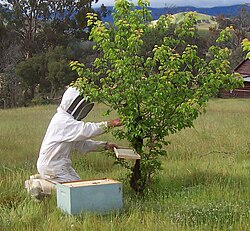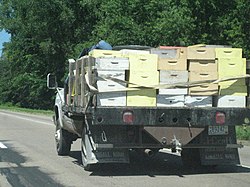Beekeeping in the United States
From Wikipedia
Beekeeping in the United States dates back to the 1860s.
Development of beekeeping in the United States
John Harbison, originally from Pennsylvania, successfully brought bee keeping to the US west coast in the 1860s, in an area now known as Harbison Canyon, California, and greatly expanded the market for honey throughout the country.
Beekeeping was traditionally practiced for the bees' honey harvest, although nowadays crop pollination service can often provide a greater part of a commercial beekeeper's income. Other hive products are pollen, royal jelly, and propolis, which are also used for nutritional and medicinal purposes, and beeswax, which is used in candle making, cosmetics, wood polish, and for modelling. The modern use of hive products has changed little since ancient times.
Western honey bees are not native to the Americas. American, Australian, and New Zealand colonists imported honey bees from Europe, partly for honey and partly for their usefulness as pollinators. The first honey bee species imported were likely European dark bees. Later Italian bees, Carniolan honey bees and Caucasian bees were added.
Western honey bees were also brought to the Primorsky Krai in Russia by Ukrainian settlers around 1850s. These Russian honey bees that are similar to the Carniolan bee were imported into the U.S. in 1990. The Russian honey bee has shown to be more resistant to the bee parasites Varroa destructor and Acarapis woodi.
Before the 1980s, most U.S. hobby beekeepers were farmers or relatives of a farmer, lived in rural areas, and kept bees with techniques passed down for generations. The arrival of tracheal mites in the 1980s and varroa mites and small hive beetles in the 1990s led to the discontinuation of the practice by most of these beekeepers as their bees could not survive among these new parasites.
In Asia, other species of Apis exist which are used by local beekeepers for honey and beeswax. Non-Apis species of honey bees, known collectively as melipolines or stingless bees, have also been kept from antiquity in Australia and Central America, although these traditions are dying, and some of the meliponine species used are endangered.
Types of beekeepers
Beekeepers generally categorize themselves as:
- Commercial beekeeper — Beekeeping is the primary source of income.
- Sideliner — Beekeeping is a secondary source of income.
- Hobbyist — Beekeeping is not a significant source of income.
Some southern U.S. and southern hemisphere (New Zealand) beekeepers keep bees primarily to raise queens and package bees for sale. In the U.S., northern beekeepers can buy early spring queens and 3- or 4-pound packages of live worker bees from the South to replenish hives that die out during the winter, although this is becoming less practical due to the spread of the Africanized bee.
In cold climates commercial beekeepers have to migrate with the seasons, hauling their hives on trucks to gentler southern climates for better wintering and early spring build-up. Many make "nucs" (small starter or nucleus colonies) for sale or replenishment of their own losses during the early spring. In the U.S. some may pollinate squash or cucumbers in Florida or make early honey from citrus groves in Florida, Texas or California. The largest demand for pollination comes from the almond groves in California. As spring moves northward so do the beekeepers, to supply bees for tree fruits, blueberries, strawberries, cranberries and later vegetables. Some commercial beekeepers alternate between pollination service and honey production but usually cannot do both at the same time.
In the Northern Hemisphere, beekeepers may harvest honey from July until October, according to the honey flows in their area. Good management requires keeping the hive free of pests and disease, and ensuring that the bee colony has room in the hive to expand. Chemical treatments, if used for parasite control, must be done in the off-season to avoid any honey contamination. Success for the hobbyist also depends on locating the apiary so bees have a good nectar source and pollen source throughout the year.
In the Southern Hemisphere, beekeeping is an all-the-year-round enterprise, although in cooler areas (to the south of Australia and New Zealand) the activity may be minimal in the winter (May to August). Consequently, the movement of commercial hives is more localized in these areas.
Bee rentals and migratory beekeeping
After the winter of 1907, US beekeeper Nephi Miller decided to try moving his hives to different areas of the country to increase their productivity during winter. Since then, "migratory beekeeping" has become widespread in America. It is a crucial element of US agriculture, which could not produce anywhere near its current levels with native pollinators alone. Beekeepers earn much more from renting their bees out for pollination than they do from honey production.
One major US beekeeper reports moving his hives from Idaho to California in January to prepare for almond pollination in February, then to apple orchards in Washington in March, to North Dakota two months later for honey production, and then back to Idaho by November — a journey of several thousands of miles. Others move from Florida to New Hampshire or to Texas. About two thirds of US domestic bees visit California for the almond bloom in February.
Keepers in Europe and Asia are generally far less mobile, with bee populations moving and mingling within a smaller geographic extent (although some keepers do move longer distances, it is much less common). This wider spread and intermingling in the US has resulted in far greater losses from Varroa mite infections in recent years.[1]
'경제는 행복의 기초 > 생산' 카테고리의 다른 글
| Royal jelly (0) | 2009.08.04 |
|---|---|
| Folk medicine (0) | 2009.08.04 |
| Honey bee life cycle (0) | 2009.08.04 |
| Honey bee (0) | 2009.08.04 |
| Honey (0) | 2009.08.04 |


